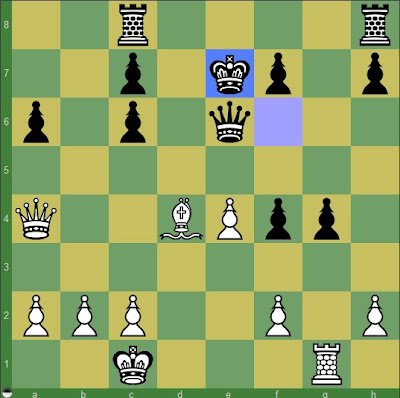1. With fresh coffee in the cup, although still groggy-eyed due to working until nearly 10:00 pm, I opened the first problem, CT 78563. Immediately, I saw the checkmate threat, and then within a few seconds saw that White had prevented my threats from going anywhere. Then, I thought to remove the queen's defender. Through simple miscalculation, I failed to see that after my capture of the knight and the exchange of queens, I would be hitting two pieces. My 1...Bg4 was the fourth most popular wrong move, and wholly ineffective.
Cause: gross miscalculation
2. After solving one problem correctly, I missed CT 47952. Laurent's urging (see comments to yesterday's post) that one must ask "what can my opponent do?" led me to reject the first move that I examined. I saw the discovered attack against queen after capture of the bishop that only appears to be en prise. As it happens, that would have been the correct move. A knight fork of king and queen refutes the discovery.
Cause: missing fork
3. My fourth problem, CT 57540, was my third failure. This time, however, I failed on the second move rather than the first. I found and executed the correct idea, but executed it badly. After the forcing check by the rook, I parried the checkmate threat with a discovery on the threatening rook. But, I moved my knight to a square where it was vulnerable to capture.
White to move
Instead of gaining a clear and decisive advantage, I put myself in a rook and pawn ending with the advantage of one pawn.
Cause: hasty failure to calculate alternative moves
4. Although I correctly solved CT 57744 and CT 48156, I made moves that were "not the computer's first choice." In 57744, I missed seeing the full mobility of my queen, finding a win of material but not the checkmate. In 48156, my second move was to check with the bishop rather than the queen. Again, I was winning material but not finding checkmate.
Cause: shallow calculation
So far today, 4/7 correct, but errors in five of seven problems. Yesterday, I had a terrible run of 31 problems in which only six were solved correctly, but then finished the day with seven correct. Starting today with 4/7 correct suggests that slowing down between problems might lead to greater success. Instead of frantic solving one problem after another, a few moments to reflect on my thinking processes after each problem might be the prescription for yesterday's malady.
5. In CT 49766, I chased illusions.* When my initial move was rejected as "not the computer's top choice," I attempted to drive the Black queen to a square where it no longer threatened my bishop. That my own queen was en prise failed to lead me to calculate variations.
White to move
It is interesting that the eye instantly catches the check on f7, and almost as instantly rejects it due to the knight on d8. Yet, in this idea is the kernel of the double attack that wins.
Cause: gross miscalculation, inflexibility
6. CT 91892 put me under 50% for the day so far.
White to move
Winning the exchange is easy, but it is important to look for more. I correctly identified White's threats along the a3-f8 diagonal, but failed to use the b-file. Instead, I sought to bring both queen and rook to the d-file.
Cause: shallow calculation
I managed to finish the day's ten problems at 50% because CT 59114 offered the resource that I missed in CT 47952. Perhaps slowly working through problems, writing down the cause of each failure, is a practice more akin to deliberate practice than trying to solve as many problems as possible in the allotted time. More likely, there is good reason to do both sorts of solving sessions.
*There was a break in my Chess Tempo session in which I took care of some morning business. During this break, I worked four problems on the Shredder iPad app. The problems in this app often call for simpler resolution than problems at the level where I'm working on CT. Could an easy problem set lead to failure when moving to harder problems? I am reminded of something that Valeri Beim wrote in Paul Morphy: A Modern Perspective (see "Beware of Weak Opponents").

















Sorry to hear that my early advice led to an error in your training today :( I hope it will bring many rewards in the future :-)
ReplyDeleteI agree with the idea that alternating easy and hard problems may be a trap, especially if you're used to solve easy problems and you don't focus enough on CT problems just yet...
Also CT allows you to go over the problems you've failed (look in options/unrated). I hate to do this because my list of failed problems is huge and most of them are, well, difficult for me, as you can expect. But still, I think it's good (deliberate) practice. I aim at solving them 10% better than my overall set (which is hard : I'm at 70% vs. 65% at the moment)
Your advice was excellent. It did not cause the failure, but led me from danger. The cause of the failure was seeing another way to address the danger. In the first problem, and likely many others, your question simply must be tempered with the question, "what can I do?"
DeleteI've done well over 2000 problems at CT in several months. Going back through every one would require a huge time commitment. Even so, CT tracks percentages by tactical motifs, and that's a handy organizational tool. But, shallow calculation, which was the recurring problem this morning, crosses all tactical motifs.
Seems that you can use some extra "tactical technique" ;)
ReplyDelete